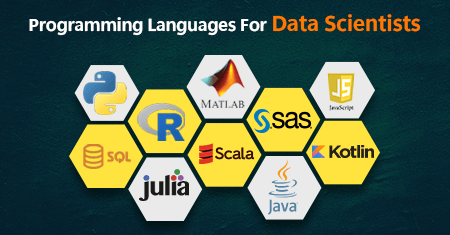Which Programming Languages Are Essential for Data Science Beginners?
In today’s data-driven world, the demand for skilled data scientists is higher than ever. As industries across the globe turn to data for decision-making, data science has become one of the most sought-after career fields. If you’re a beginner eager to dive into this world, you may wonder which programming languages to start with. Data science requires expertise in several tools, and programming languages form the backbone of this expertise.
In this article, we’ll explore the programming languages to learn for data science beginners. We’ll explain why they are crucial, how they are used, and the benefits of learning each one. By the end, you’ll have a clearer understanding of where to start on your journey to becoming a data science professional.
Why Learning Programming Is Key to Data Science Success
Data science involves more than just collecting and processing data—it requires the ability to manipulate, analyze, and visualize data to extract meaningful insights. This is where programming languages come into play. Programming languages allow data scientists to:
- Clean and preprocess raw data
- Build predictive models
- Perform statistical analysis
- Visualize trends and patterns in data
- Automate repetitive tasks
For beginners, learning these languages is essential for building a foundation in data science. Each language has its own strengths and areas of application, and choosing the right one depends on your specific goals and the type of projects you want to work on.
Let’s dive into the most important programming languages for data science beginners.
1. Python: The All-Rounder of Data Science
Python is, without a doubt, the most popular programming language in the world of data science. Known for its simplicity and versatility, Python is the ideal starting point for beginners looking to enter the data science field.
Why Python Is Essential for Data Science Beginners
- Easy to Learn: Python’s syntax is straightforward and similar to English, making it beginner-friendly. Its readability allows new learners to focus on understanding the logic of their code rather than getting bogged down by complex syntax.
- Versatile Libraries: Python boasts a rich ecosystem of libraries and frameworks specifically designed for data science. Popular libraries like Pandas (for data manipulation), NumPy (for numerical computing), Matplotlib and Seaborn (for data visualization), and Scikit-learn (for machine learning) make Python an all-in-one tool.
- Wide Usage in Machine Learning: If you’re planning to dive into machine learning (a crucial aspect of data science), Python is a must. Its libraries like TensorFlow, Keras, and PyTorch simplify the process of building neural networks and predictive models.
- Large Community Support: Python has an enormous community of developers and data scientists who contribute to its growth and provide ample resources for learners.
How Python Is Used in Data Science
- Data cleaning and preprocessing
- Exploratory data analysis (EDA)
- Statistical modeling
- Machine learning and deep learning
- Data visualization
For any beginner aiming to become a data scientist, learning Python should be a top priority. Its flexibility allows you to tackle a wide range of data-related tasks, making it an indispensable tool.
2. R: The Statistical Powerhouse
R is another critical programming language for data science, particularly if you’re interested in statistical analysis. Originally developed for statisticians, R has evolved into a powerful language used by data scientists worldwide for data analysis and visualization.
Why R Is Essential for Data Science Beginners
- Built for Statistics: R was designed for statistical computing, making it the best language for tasks that involve statistical analysis, hypothesis testing, and data visualization.
- Advanced Data Visualization: R’s data visualization capabilities are among the best, thanks to libraries like ggplot2 and plotly. You can create publication-quality plots, graphs, and charts, which are vital for presenting data insights.
- Rich Repository of Packages: R’s Comprehensive R Archive Network (CRAN) hosts thousands of packages that extend its functionality, from data manipulation to advanced machine learning models.
- Data Handling Capabilities: R’s ability to handle large data sets makes it a solid choice for working with big data, especially when combined with packages like dplyr and tidyr.
How R Is Used in Data Science
- Statistical analysis and modeling
- Data visualization and reporting
- Data mining and exploratory analysis
- Predictive modeling
For beginners interested in data science’s statistical side, learning R is highly recommended. It’s particularly useful for those pursuing careers in academic research, bioinformatics, and any field that relies heavily on statistical methods.
3. SQL: The Backbone of Data Management
While Python and R are great for data manipulation and analysis, SQL (Structured Query Language) is essential for interacting with databases. In data science, the ability to extract and query data from databases is a foundational skill, and SQL is the most widely used language for this purpose.
Why SQL Is Essential for Data Science Beginners
- Data Retrieval: Data scientists often work with large datasets stored in relational databases like MySQL, PostgreSQL, or Microsoft SQL Server. SQL allows you to retrieve, filter, and manipulate data with ease.
- Efficient Data Management: SQL is designed for managing and querying structured data. Its simplicity and efficiency make it ideal for tasks that involve filtering and aggregating large datasets.
- Industry Demand: Almost every data science job description includes SQL as a required skill. Whether you’re working for a startup or a large enterprise, SQL is indispensable when it comes to handling database-driven data.
How SQL Is Used in Data Science
- Querying databases for data extraction
- Joining and merging multiple data sources
- Filtering and aggregating data
- Creating and managing database tables
While SQL may not be as versatile as Python or R for performing complex data analysis, it is an essential tool for managing and querying the structured data stored in databases, making it a must-learn for any data science beginner.
4. Java: The Workhorse for Big Data
Java may not be the first language that comes to mind when you think of data science, but it plays a significant role, especially in big data analysis. Java’s performance, scalability, and cross-platform support make it an ideal choice for building large-scale data applications.
Why Java Is Essential for Data Science Beginners
- High Performance: Java is a statically-typed, compiled language, which makes it faster than interpreted languages like Python and R. This is crucial for handling massive datasets.
- Used in Big Data Technologies: Java is the language behind popular big data frameworks like Apache Hadoop and Apache Spark. If you’re working on big data projects, Java will be invaluable.
- Scalability: Java’s ability to scale makes it ideal for developing large-scale data processing applications, particularly in distributed computing environments.
How Java Is Used in Data Science
- Processing large datasets in Hadoop and Spark
- Building scalable data applications
- Handling complex data pipelines
While Java may not be as beginner-friendly as Python, its role in big data processing makes it an important language to learn, particularly for those interested in big data technologies and infrastructure.
5. Scala: A Functional Approach to Big Data
Scala is another language that deserves attention, especially if you plan to work with Apache Spark, one of the most powerful big data processing frameworks. Scala’s functional programming capabilities and compatibility with Java make it a great choice for handling large-scale data tasks.
Why Scala Is Essential for Data Science Beginners
- Apache Spark Integration: Scala is the native language for Apache Spark, giving it an edge over Python in terms of performance when dealing with large data sets.
- Functional Programming: Scala’s support for functional programming paradigms makes it ideal for writing concise, efficient code for data transformations and parallel processing.
- Java Compatibility: Scala runs on the Java Virtual Machine (JVM), meaning it can seamlessly integrate with existing Java code and libraries, providing greater flexibility.
How Scala Is Used in Data Science
- Big data processing with Apache Spark
- Data transformations and parallel computing
- Developing scalable data applications
Scala is more complex than Python but offers superior performance for big data processing. Beginners interested in working with distributed data systems should consider learning Scala alongside Spark.
6. MATLAB: A Specialized Tool for Numerical Computing
While not as common as Python or R in general data science tasks, MATLAB is a specialized language used for numerical computing, simulations, and algorithm development. It’s widely used in fields like engineering, physics, and financial modeling.
Why MATLAB Is Essential for Data Science Beginners
- Numerical Computing: MATLAB is designed for performing complex mathematical computations and simulations, making it ideal for numerical data analysis.
- Rich Toolboxes: MATLAB offers a wide range of toolboxes for specific applications, such as signal processing, image analysis, and control systems, which can be applied to data science tasks.
- Visualization Capabilities: MATLAB’s built-in visualization tools are excellent for creating detailed plots and graphs for data analysis.
How MATLAB Is Used in Data Science
- Numerical data analysis and simulations
- Algorithm development and testing
- Visualizing complex data sets
Although MATLAB may not be a primary language for data science, its powerful numerical capabilities make it useful for specific data science tasks, particularly in research and academic settings.
7. Julia: The High-Performance Newcomer
Julia is a newer language gaining traction in the data science community due to its speed and performance, especially in numerical and scientific computing. It combines the speed of languages like C and Fortran with the ease of use of Python.
Why Julia Is Essential for Data Science Beginners
- Speed: Julia’s execution speed rivals lower-level languages like C, making it ideal for tasks that require heavy computation.
- Parallel Computing: Julia has built-in support for parallel computing, allowing for faster data processing and model training.
- Ease of Use: Like Python, Julia is easy to learn and has a clean, readable syntax.
How Julia Is Used in Data Science
- High-performance numerical analysis
- Machine learning and artificial intelligence
- Large-scale data processing
While Julia is still relatively new, its performance advantages make it a strong contender for data science tasks that require computational efficiency.
Conclusion
For beginners in data science, choosing the right programming language can feel overwhelming, but it’s important to focus on the essentials. Python and R are the go-to languages for most data science tasks, offering versatility, ease of use, and powerful libraries for data manipulation, analysis, and visualization. SQL is crucial for querying databases, while languages like Java, Scala, MATLAB, and Julia offer specialized advantages for big data and numerical computing.
Start with Python, as it is the most beginner-friendly and widely used in the field. As you advance, consider learning additional languages based on the types of projects you want to work on and the industries you’re interested in. By building a strong foundation in these programming languages, you’ll be well-equipped to tackle the challenges of data science and unlock the full potential of data.
In the dynamic field of data science, being proficient in multiple languages will ultimately help you stand out and adapt to new tools and technologies as they emerge. Happy coding!
click here to visit website






